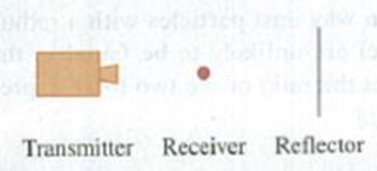
DATA As a physics lab instructor, you

Use the data to calculate c, the speed of the
Figure P32.50

Want to see the full answer?
Check out a sample textbook solution
Chapter 32 Solutions
University Physics with Modern Physics Plus Mastering Physics with eText -- Access Card Package (14th Edition)
Additional Science Textbook Solutions
Essential University Physics: Volume 2 (3rd Edition)
Modern Physics
Physics for Scientists and Engineers: A Strategic Approach with Modern Physics (4th Edition)
The Cosmic Perspective (8th Edition)
Introduction to Electrodynamics
- The electric part of an electromagnetic wave is given by E(x, t) = 0.75 sin (0.30x t) V/m in SI units. a. What are the amplitudes Emax and Bmax? b. What are the angular wave number and the wavelength? c. What is the propagation velocity? d. What are the angular frequency, frequency, and period?arrow_forwardA radio antenna broadcasts a 1.0 MHz radio wave with 25 kW of power. Assume that the radiation is emitted uniformly in all directions.a. What is the wave’s intensity 30 km from the antenna?b. What is the electric field amplitude at this distance?arrow_forwardLasers can be constructed that produce an extremely high intensity electromagnetic wave for a brief time. These devices are called pulsed lasers and can be used to ignite nuclear fusion, for example. Consider a pulsed laser that produces an electromagnetic wave with a maximum electric field strength of 2.73 × 1011 V/m for a duration of 1.00 ns. What energy does it deliver on a 1.00 mm² area? Assume, for simplicity, that the sinusoidal electric field has the same amplitude (i.e., constant maximum electric field strength) throughout the duration of the pulse.arrow_forward
- The maximum allowed leakage of microwave radiation from a microwave oven is 5.0 mW/cm2. If microwave radiation outside an oven has the maximum value, what is the amplitude of the oscillating electric field?arrow_forwardRadiation of a single frequency reaches the upper atmosphere of the earth with an intensity of 1350 W/m². What is the maximum value of the electric field associated with this radiation? Provide the answer: V/marrow_forwardConsider an electromagnetic wave travelling in a vacuum with an electric field given by E(y,t)=(3×106 [V/m])î cos [ky+(2.7×1015 [rad/s])t]. What are the direction, frequency, and wavelength of the traveling wave? A. The EM wave is traveling along the k direction with frequency 44.8×105 Hz and wavelength 6.3×102 m. B.The EM wave is travelling along the j direction with frequency 1.7×1016 Hz and wavelength 1.8×10−8 m. C.The EM wave is travelling along the −j direction with frequency 4.3×1014 Hz and wavelength 7.0×10−7 m. D. The EM wave is travelling along the î direction with frequency 2.7×1015 Hz and wavelength 1.1×10−7 m.arrow_forward
- Biologists often study the patterns of migratory birds by using radar (1–10 GHz electromagnetic waves) to track their flight. To check whether radar waves influence the birds’ flight, researchers tracked the birds visually, both with the radar on and with it off. The 9 GHz radar waves had an intensity of 400 W/m2 at 250 m. What was the amplitude of the electric field at this distance? (The experiments showed that the radar did not affect the birds.)arrow_forwardAnswer the sub-questions that follow. Consider the given electromagnetic wave travelling in a vacuum with electric field given.arrow_forwardLasers can be constructed that produce an extremely high intensity electromagnetic wave for a brief time. These devices are called pulsed lasers and can be used to ignite nuclear fusion, for example. Consider a pulsed laser that produces an electromagnetic wave with a maximum electric field strength of 1.25×10^11 V/m for a duration of 1.00 ns. What energy does it deliver on a 1.00 mm^2 area? Give your answer in units of kilojoules.arrow_forward
- The microwave radiation left over from the Big Bang explosion of the universe has an average energy density of 4.07 × 10–14 J/m3. What is the rms value of the electric field of this radiation?arrow_forwardA 13.0-mW helium-neon laser emits a beam of circular cross section with a diameter of 3.10 mm. (a) Find the maximum electric field in the beam. (b) What total energy is contained in a 1.00-m length of the beam? (c) Find the momentum carried by a 1.00-m length of the beam. Step 1 We will find the reasonable size of the electric field in a beam of bright light. At the speed of light, only a small fraction of a joule is contained in a meter-length beam. The momentum of the beam is a very small fraction of a kg. m/s. Light is described by energy and momentum but possesses no mass. Step 2 We will use the equation relating the intensity of light to the wave amplitude. From the definition of intensity, we can find the energy content of the beam of light. Then the relationship between momentum, energy, and the speed of light will give us the momentum of a length of the beam. Step 3 The intensity of light I is given by the average magnitude of the Poynting vector. We have 2 I = S₂ avg P Tr²…arrow_forwardElectromagnetic waves can propagate through a vacuum. The speed of electromagnetic waves in a medium is always greater than the speed of light in vacuum. Electromagnetic waves can exhibit both particle-like and wave-like properties. The energy carried by an electromagnetic wave is directly proportional to its frequency. The electromagnetic spectrum encompasses a wide range of wavelengths, from radio waves to gamma rays. True or False ?arrow_forward
 Physics for Scientists and Engineers: Foundations...PhysicsISBN:9781133939146Author:Katz, Debora M.Publisher:Cengage Learning
Physics for Scientists and Engineers: Foundations...PhysicsISBN:9781133939146Author:Katz, Debora M.Publisher:Cengage Learning
